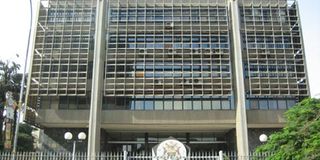Has BoU’s consistent rate reduction been effective?

Bank of Uganda premises in Kampala. FILE PHOTO
What you need to know:
- The prospects for the economy in 2016/17, indicate that growth will be at a much slower pace than expected at the start of the financial year.
- Central Bank governor Emmanuel Tumusiime-Mutebile told reporters that he expects the economy to grow at 4.5 percent instead of the initially projected growth of 5 percent.
Kampala. Even though Bank of Uganda (BoU) does not want to admit it, the Monetary Policy Committee that sets the Central Bank Rate (CBR) was hard pressed when reducing the rate last week from 12 per cent to 11.5 per cent.
The market, especially bankers, did not expect BoU to further continue easing lending rates because of concerns about the drought conditions edging inflation upwards.
Nonetheless, the meeting opted for a rate cut in what Central Bank governor Emmanuel Tumusiime-Mutebile described as “boosting economic activity.”
The reduction marked almost a year of easing by BoU.
In the April 2016 meeting, the rate had been reduced from 17 per cent to 16 per cent.
Since then, the meetings have been reducing the rate.
In reducing, the ultimate signal BoU was sending to commercial banks was that risks have reduced to slash lending rates.
And in essence, BoU thinks this reduction is working.
“The fact that we are easing and seeing the private sector is borrowing again, shows that there is a big element of the BoU’s action,” Dr Adam Mugume, the executive director of research at BoU told reporters after the issuance of the Monetary Policy Statement last week.
He added: “Also, remember that by the time we started easing, lending interest rates on average were at 25 per cent. Now we are seeing a reduction to 22.7 per cent, which is a 2.5 per cent reduction in lending rates. That is equally positive. That in a way is boosting economic activity.”
Commercial bank interest rates have been sticky downwards.
The average rate has fallen from 24.8 per cent in May 2016 to 23.7 percent in January 2017.
This still shows that there is still caution in the wind for commercial banks.
The indicator is visible in the borrowing by the private sector that has only grown 3 per cent year-on-year to December 2016.
According to Mr Patrick Mweheire, the chief executive officer (CEO) Stanbic Bank Uganda, this credit growth is one of the worst the country has experienced.
“In 2016, we saw a number of things in our economy that have not happened in a long time. We are really concerned on how we get our growth back up to high single digits,” he said recently at the Stanbic Uganda Economic Outlook Forum.
He added: “One of the more hairy statistics for me being in the banking sector was the fact that credit growth in 2016 was lower than GDP growth. We have not seen that in a long time. Credit growth in the market was less than 3 per cent and yet GDP was around 5 per cent.”
BoU statistics show borrowing by the private sector grew from Shs10.7 trillion to Shs11.5 trillion in December 2016.
Banks are still exercising caution because of the loan defaults that continue to exist.
That means borrowers are still risky even though lending rates have reduced slightly.
Attractive government borrowing rates
The rates on government securities continue to be attractive, however, they’re dropping.
If this consistency continues banks are expected to slowly turn back to lending to the private sector.
Statistics indicate that there is a decline on the rates government is borrowing at from an average of 16.2 per cent in May 2016 to 15.2 per cent in January 2017 on the 364 days treasury bill and 16.5 per cent in May 2016 to 16 per cent in January 2017 on the 5-year treasury bond.
“We are beginning to see a convergence between the CBR and rates on government securities. The banks will begin to have a rate that is closer to the CBR because now the private sector will become more attractive to lend to,” said Mr Herman Kasekende, the outgoing CEO of Standard Chartered Bank Uganda.
The rates on government securities however still remain attractive as they are still about 4 percentage points higher than the CBR.
The prospects for the economy in 2016/17, indicate that growth will be at a much slower pace than expected at the start of the financial year.
Mr Mutebile told reporters that he expects the economy to grow at 4.5 percent instead of the initially projected growth of 5 percent.
The reasoning for the slowed growth, according to BoU is for reasons beyond what they can control; the adverse drought conditions that could see food prices continue to go up. In the statement, Mr Mutebile describes the slowing economy as being due to “temporary adverse weather-related factors.”
If the impact of the rate reductions is to be felt, it will have to be beyond the decision at BoU.



